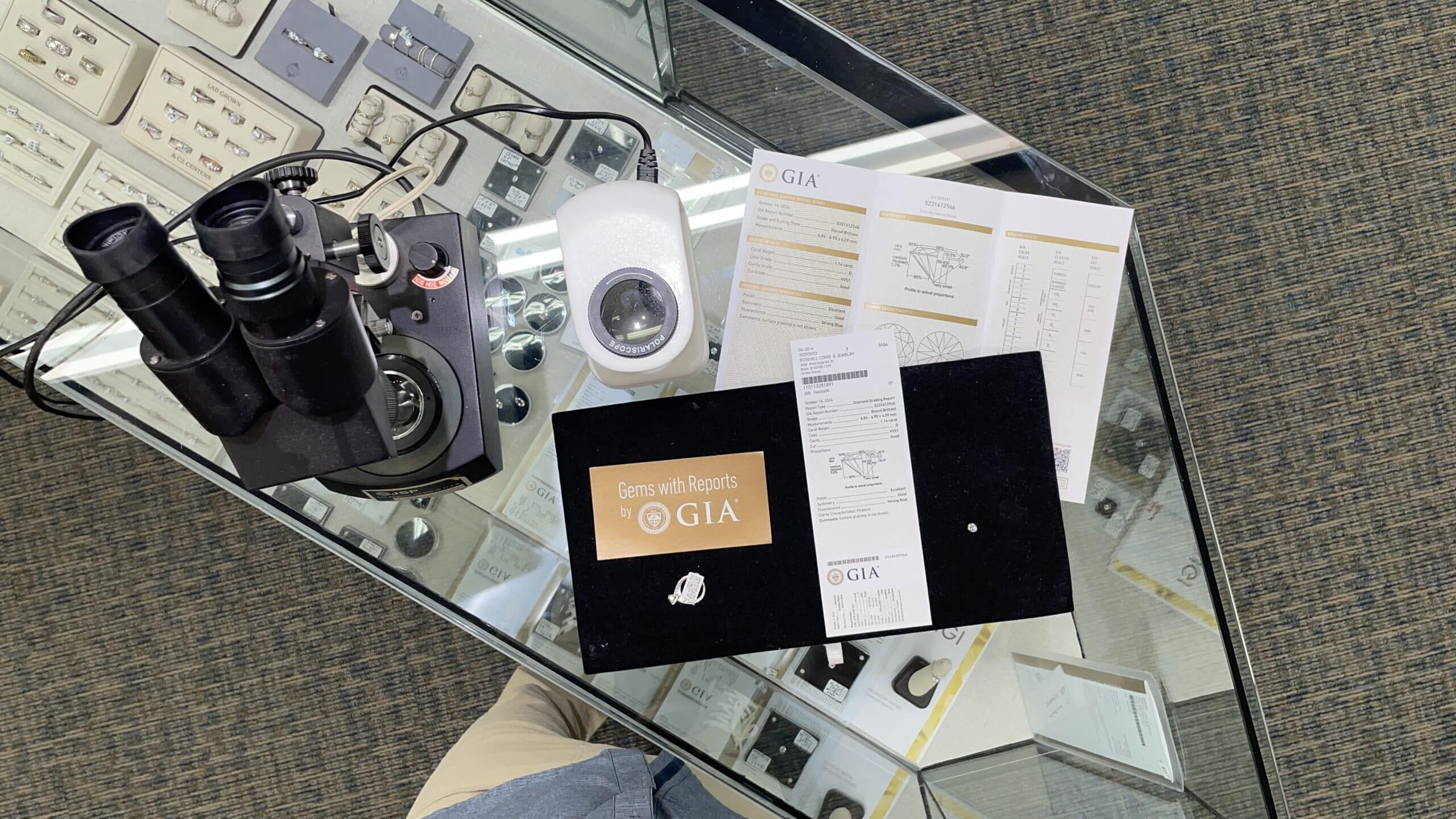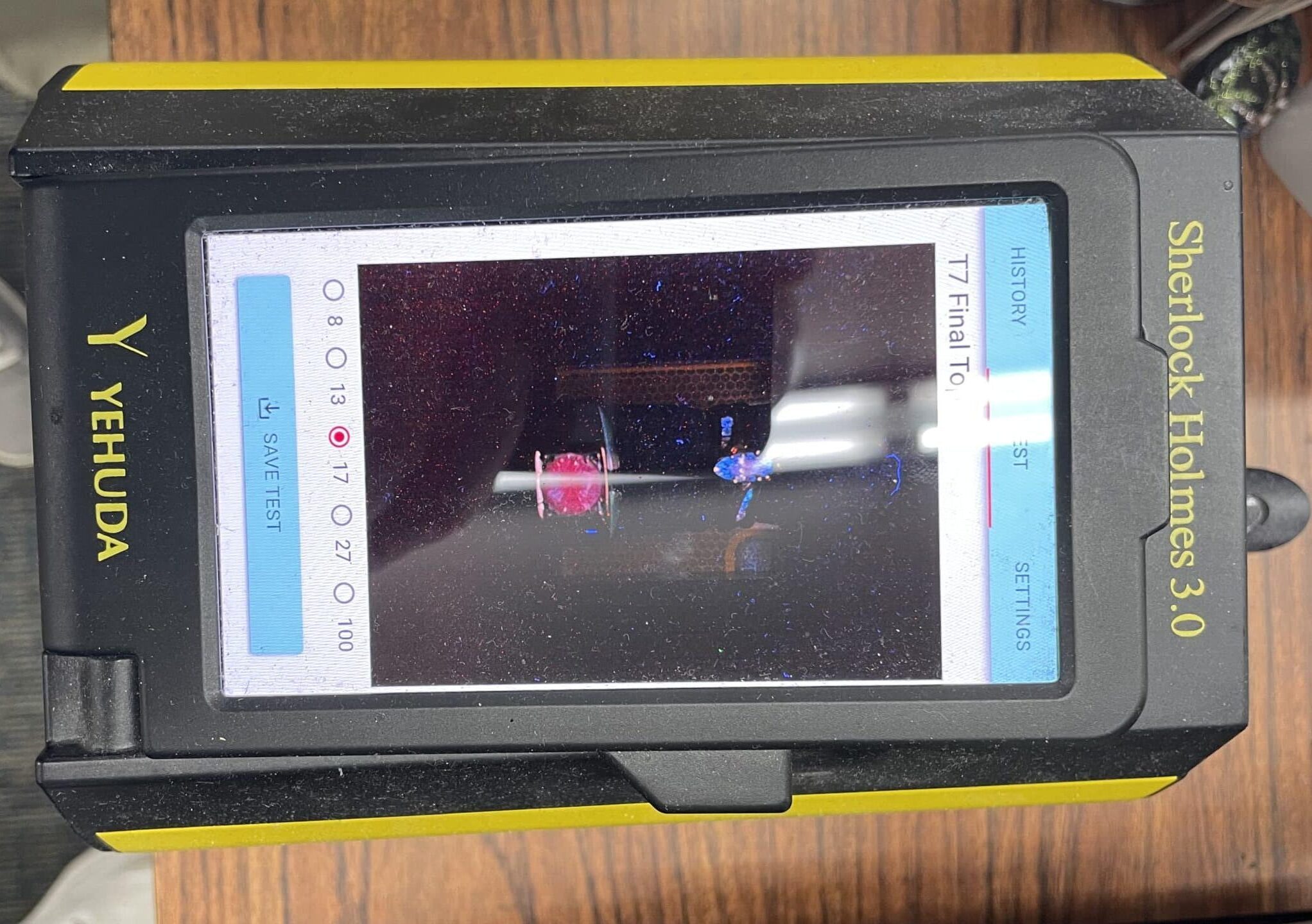Certified Diamonds
We inventory a wide section of certified diamonds for you to choose from.
We Sell GIA Certified Diamonds
GIA (Gemological Institute of America) is the gold standard in diamond grading. When a gemstone is described as “GIA certified,” it means that the gemstone has been analyzed and graded by GIA’s team of expert gemologists. A GIA certificate provides an unbiased assessment of a diamond’s characteristics, including its 4Cs: carat, color, clarity, and cut.

What is Diamond Certification?
Your Certified Diamond Questions Answered
Investing in certified gold can be a rewarding experience. Here are some common questions to help guide your decisions.
The 4Cs of Diamond Grading
Certification primarily focuses on the famous “4Cs” that determine a diamond’s value:
- Carat Weight: The measurement of a diamond’s mass, where one carat equals 0.2 grams.
- Cut: Evaluates how well the diamond has been shaped and faceted, affecting its brilliance and sparkle. This includes proportions, symmetry, and polish.
- Color: Measures the absence of color in a diamond, typically on a scale from D (completely colorless) to Z (light yellow or brown).
- Clarity: Assesses the presence of internal (inclusions) or external (blemishes) imperfections, ranging from Flawless (FL) to Included (I).
Diamond Carat: A Comprehensive Explanation
A carat is the standard unit of weight used specifically for measuring diamonds and other gemstones. The word “carat” comes from the Greek word “keration,” referring to the carob seed. Historically, carob seeds were used as counterweights in balance scales because they were believed to have a remarkably consistent weight.
Key Facts About Carats
- Definition: One carat equals exactly 200 milligrams (0.2 grams)
- Subdivision: Each carat is divided into 100 points, allowing for precise measurements (e.g., a 0.75-carat diamond is often called a “75-point diamond”)
- Pronunciation: Despite the spelling similarity, “carat” for gemstones is different from “karat,” which measures gold purity
Carat Weight and Diamond Size
An important distinction exists between a diamond’s carat weight and its apparent size:
- Two diamonds of equal carat weight may appear different in size depending on:
- Cut proportions (deeper cuts hide weight in depth)
- Shape (elongated shapes like oval or marquise often appear larger)
- Setting style (certain settings can create an illusion of greater size)
Carat Weight and Value Relationship
The relationship between carat weight and price follows a non-linear progression:
- Price Jumps: Diamond prices typically jump at whole and half-carat weights (1.00, 1.50, 2.00 carats)
- Exponential Value: As carat weight increases, price increases exponentially rather than proportionally
- Rarity Factor: Larger diamonds are disproportionately more valuable because they are exponentially rarer in nature
For example, a 2-carat diamond typically costs significantly more than twice the price of a 1-carat diamond of equivalent quality, due to this rarity premium.
Practical Considerations for Buyers
When considering carat weight, savvy buyers should:
- Look for “Magic Sizes”: Consider diamonds just below whole-carat weights (e.g., 0.90-0.99 carats instead of 1.00) for potential savings
- Prioritize Cut Over Size: A smaller, excellently-cut diamond often appears more brilliant than a larger, poorly-cut stone
- Consider Finger Size: The same carat weight can look dramatically different on different hand sizes
- Account for Setting Impact: Certain settings (halo, cluster) can maximize the appearance of carat weight
Carat Weight in History
The modern definition of the carat (200mg) was standardized at the Fourth General Conference on Weights and Measures in 1907 and adopted in the United States in 1913. Before this standardization, the carat varied slightly from country to country, creating complications in international diamond trade.
Common Misconceptions
- Carat Equals Size: Many consumers mistakenly believe carat refers directly to size rather than weight
- Bigger Is Always Better: Higher carat weight doesn’t necessarily mean higher quality or beauty
- All Diamonds Are Weighed the Same: Only diamonds and precious gemstones use the carat system; other materials use different measurements
Understanding carat weight as one factor among the 4Cs helps consumers make more informed diamond purchases, balancing size considerations with quality factors that affect a diamond’s overall beauty and value.
Major Certification Laboratories
The most respected diamond certification laboratories include:
- GIA (Gemological Institute of America): Considered the gold standard in diamond certification worldwide, known for consistent and strict grading standards.
- AGS (American Gem Society): Renowned for its scientific approach and especially valued for cut grading.
- IGI (International Gemological Institute): One of the largest labs, popular for certifying diamonds used in retail jewelry.
- HRD (Hoge Raad voor Diamant): Prominent in Europe, especially for diamonds from Antwerp, Belgium.
- GSI (Gemological Science International): Commonly used by many large retail chains.
Beyond the 4Cs: Additional Information
Comprehensive diamond certificates also include:
- Proportions and measurements
- Fluorescence (reaction to UV light)
- Diamond plot (map of inclusions)
- Laser inscription (microscopic engraving of certificate number)
- Cut grade details (for some labs)
- Symmetry and polish ratings
The Importance of Certification
Diamond certification serves multiple purposes:
Consumer Protection: Certification helps consumers make informed decisions and ensures they’re paying a fair price relative to the diamond’s quality.
Resale Value: Certified diamonds, especially those with GIA or AGS reports, typically maintain better resale value and marketability.
Insurance: Most insurance companies require certification for diamond jewelry coverage, using the document to establish replacement value.
Fraud Prevention: Certification helps prevent misrepresentation and substitution of diamonds with lower-quality stones.
Limitations of Certification
Despite their importance, certificates have limitations:
- Grading remains somewhat subjective, with slight variations between laboratories
- Not all certificates are created equal—different labs may have different standards
- A certificate cannot fully convey a diamond’s visual appeal or “fire”
- Certificates can become outdated if a diamond is recut or damaged
Recent Developments
The diamond certification industry has evolved with technology:
- Blockchain technology is being implemented to create tamper-proof digital certificates
- Advanced scanning technologies provide more detailed analysis of diamonds
- Some labs now include ethical sourcing information on certificates
- Mobile apps allow instant verification of certificate authenticity
Choosing a Certified Diamond
When purchasing a certified diamond, experts recommend:
- Prioritizing certificates from GIA or AGS for major purchases
- Personally examining the diamond rather than relying solely on the certificate
- Understanding that certificates are tools for comparison, not guarantees of beauty
- Being wary of diamonds with multiple certificates showing different grades
- Ensuring the certificate matches the diamond by checking the laser inscription
Got more Questions?
Our Diamond Tester Has Answers
CVD and hpht lab grown diamond detector by Yehuda.

Discover The Beauty of Certified Diamonds
Contact Rose Hill Coin and Jewelry today to discover our exquisite collection of certified diamonds. Our expert team will guide you through selecting the perfect gem that combines buying assurance with timeless elegance.
